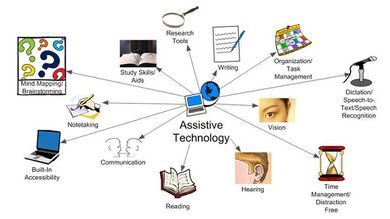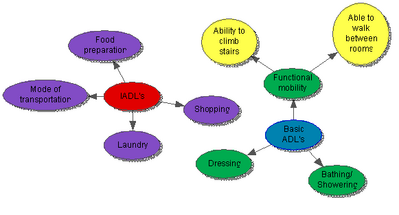Technological Aids for Self-Care and Environmental Adaptations: Difference between revisions
No edit summary |
No edit summary |
||
| Line 2: | Line 2: | ||
<div class="noeditbox">Welcome to [[Assistive Technology Content Development Project|Assistive Technology in Rehabilitation Content Development Project]]. Please do not edit unless you are involved in this project, but please come back in the near future to check out new information!! If you would like to get involved in this project and earn accreditation for your contributions, please get in touch!</div> <div class="editorbox"> | <div class="noeditbox">Welcome to [[Assistive Technology Content Development Project|Assistive Technology in Rehabilitation Content Development Project]]. Please do not edit unless you are involved in this project, but please come back in the near future to check out new information!! If you would like to get involved in this project and earn accreditation for your contributions, please get in touch!</div> <div class="editorbox"> | ||
'''Original Editors ''' - [[User: | '''Original Editors ''' - [[User:Lucinda hampton|Lucinda hampton]] | ||
'''Top Contributors''' - {{Special:Contributors/{{FULLPAGENAME}}}} | '''Top Contributors''' - {{Special:Contributors/{{FULLPAGENAME}}}} | ||
| Line 10: | Line 10: | ||
[[File:Assistive Technology.jpeg|right|frameless|390x390px]]Self-Care is what people do for themselves to establish and maintain health, and to prevent and deal with illness. It is a broad concept encompassing hygiene (general and person | [[File:Assistive Technology.jpeg|right|frameless|390x390px]]Self-Care is what people do for themselves to establish and maintain health, and to prevent and deal with illness. It is a broad concept encompassing hygiene (general and person | ||
[[Category:Assistive Technology Content Development Project]] | [[Category:Assistive Technology Content Development Project]] | ||
al), [[nutrition]] (type and quality of food eaten), lifestyle (sporting activities, leisure etc), environmental factors (living conditions, social habits, etc.) [[Social Determinants of Health|socio-economic]] factors (income level, cultural beliefs, etc.) and self-medication''.''<ref>ISF What is self care Available: https://isfglobal.org/what-is-self-care/ (accessed 10.7.2021)</ref> | al), [[nutrition]] (type and quality of food eaten), lifestyle (sporting activities, leisure etc), environmental factors (living conditions, social habits, etc.) [[Social Determinants of Health|socio-economic]] factors (income level, [[Personal Values and Beliefs|cultural beliefs]], etc.) and self-medication''.''<ref>ISF What is self care Available: https://isfglobal.org/what-is-self-care/ (accessed 10.7.2021)</ref> | ||
* Self-care is the fundamental level of health care in all societies and should be seen as a major public health resource. | * Self-care is the fundamental level of health care in all societies and should be seen as a major public health resource. | ||
| Line 19: | Line 19: | ||
* Physical modifications in the built environment, including ramps, grab bars, and wider doorways to enable access to buildings, businesses, and workplaces. | * Physical modifications in the built environment, including ramps, grab bars, and wider doorways to enable access to buildings, businesses, and workplaces. | ||
* | * [[Assistive Technology: Mobility Products|Mobility Products]]. | ||
* Adaptive switches and utensils to allow those with limited motor skills to eat, play games, and accomplish other activities. | * Adaptive switches and utensils to allow those with limited motor skills to eat, play games, and accomplish other activities. | ||
* Devices and features of devices to help perform tasks such as cooking, dressing, and grooming; specialized handles and grips, tub benches abs shower stools, devices that extend reach, and lights on telephones and doorbells. | * [[Assistive Devices|Devices and features of devices to help perform tasks]] such as cooking, dressing, and grooming; specialized handles and grips, tub benches abs shower stools, devices that extend reach, and lights on telephones and doorbells. | ||
* | * [[What is Assistive Technology|Assistive Technology]].<ref>NIH Assistive Devices Available: https://www.nichd.nih.gov/health/topics/rehabtech/conditioninfo/device (accessed 10.7.2021)</ref> | ||
* Wheelchair | * [[Wheelchair Fitting|Wheelchair]]<nowiki/>s and [[Walking Aids]] | ||
* | * [[Positioning the Child with Cerebral Palsy|Posture control aides for cerebral palsy]] | ||
* Pressure mattress | * [[Guidelines on Prevention and Management of Pressure Ulcers|Pressure mattress]] | ||
* Sling or hoist | * [[Cushions]] | ||
* [[Transfer Aids|Sling or hoist]] | |||
* Complex home modifications | * Complex home modifications | ||
* Mobile or ceiling hoist | * Mobile or ceiling hoist | ||
Revision as of 06:59, 17 July 2021
Original Editors - Lucinda hampton
Top Contributors - Lucinda hampton, Mahbubur Rahman, Naomi O'Reilly, Kim Jackson and Ewa Jaraczewska
Defining Self Care[edit | edit source]
Self-Care is what people do for themselves to establish and maintain health, and to prevent and deal with illness. It is a broad concept encompassing hygiene (general and personal), nutrition (type and quality of food eaten), lifestyle (sporting activities, leisure etc), environmental factors (living conditions, social habits, etc.) socio-economic factors (income level, cultural beliefs, etc.) and self-medication.[1]
- Self-care is the fundamental level of health care in all societies and should be seen as a major public health resource.
- Self-care is often unrecognised and underappreciated.
Examples[edit | edit source]
Self Care and Environment Products adapt the environment, rather than the person, to support identified needs, choice, and control. These assistive devices may compensate for impairments and functional limitations and enable a quicker, safer, or more-efficient performance of everyday activities. Products may address vision, hearing, fine and gross motor, sensory, cognitive, communication, safety, and learning.[2]- Physical modifications in the built environment, including ramps, grab bars, and wider doorways to enable access to buildings, businesses, and workplaces.
- Mobility Products.
- Adaptive switches and utensils to allow those with limited motor skills to eat, play games, and accomplish other activities.
- Devices and features of devices to help perform tasks such as cooking, dressing, and grooming; specialized handles and grips, tub benches abs shower stools, devices that extend reach, and lights on telephones and doorbells.
- Assistive Technology.[3]
- Wheelchairs and Walking Aids
- Posture control aides for cerebral palsy
- Pressure mattress
- Cushions
- Sling or hoist
- Complex home modifications
- Mobile or ceiling hoist
- Reminders applications[4]
Home adaptation, using these devices, is a complex procedure whose implementation involves the execution of multiple actions
- detection of individual needs
- contact with several specialised professional profiles
- visits to orthopaedics or companies in the sector
- selection of the right device
- search for financing options
- purchase and installation of the selected assistive products[5]
Cost Barriers[edit | edit source]
Despite the growing need, one of the primary barriers to obtaining needed or wanted self care and environmental products is cost; ie a large number of people with disabilities cannot afford them and get no reimbursement for them through existing funding systems. Eg tub benches have been found to support function and safety, they are typically not funded through third-party reimbursement systems, as they are considered “optional” and do not qualify as durable medical equipment. In response, a number of initiatives have occurred to increase access. Eg In the United States, a national network of alternative financing programs offers a consumer-directed program and range of alternative financing strategies to increase access to funding for these products and other technologies; Canada and Sweden, have implemented delivery systems that offer more-extensive access to these products as part of integrated community living plans[2].References [edit | edit source]
- ↑ ISF What is self care Available: https://isfglobal.org/what-is-self-care/ (accessed 10.7.2021)
- ↑ 2.0 2.1 Britannica AIDS for ADL Available:https://www.britannica.com/topic/aids-for-activities-of-daily-living (accessed 10.7.2021)
- ↑ NIH Assistive Devices Available: https://www.nichd.nih.gov/health/topics/rehabtech/conditioninfo/device (accessed 10.7.2021)
- ↑ Ability action.Assistive Technology available:https://abilityactionaustralia.com.au/assistive-technology-equipment-aids-occupational-therapy/ (accessed 10.7.2021)
- ↑ Plos one Exploring the use of assistive products to promote functional independence in self-care activities in the bathroom Available: https://journals.plos.org/plosone/article?id=10.1371/journal.pone.0215002 ( accessed 10.7.2021)









